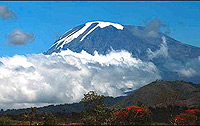A phalanx of celebrities is climbing Kilimanjaro, Africa’s highest peak, for Comic Relief. But if Chris Moyles can make the ascent, is it really easy? The most popular trail for climbing Africa’s highest mountain is dismissively known as the “Coca Cola route”.


A phalanx of celebrities is climbing Kilimanjaro, Africa’s highest peak, for Comic Relief. But if Chris Moyles can make the ascent, is it really easy? The most popular trail for climbing Africa’s highest mountain is dismissively known as the "Coca Cola route”.
It has comfortable huts for tourists to sleep in, food and drink is for sale and the paths are thronged with climbers. But while it’s fair to say that climbing the nearly 6,000m Kilimanjaro is not akin to climbing Everest or K2, it’s still something to be approached with care.
Altitude is the key, says Simon Mtuy, who as well as leading trips up the mountain holds the record for the quickest ascent and descent, managing in eight-and-a-half hours what takes the tourists six days.
"It is a very high mountain. Normally people take five or six days. Travelling 1500-2000m in a day is a lot for one person who lives at sea level.” And the consequence of climbing too high, too quickly, is altitude sickness.
Climbers get headaches, suffer vomiting and struggle with their digestive system. Of those who make the trip with Mtuy, 60-70% suffer strong symptoms and everybody feels something.
The essence is not bounding ahead enthusiastically, says Jon Garside, training officer of the British Mountaineering Council, who led a party of teenagers up the mountain in 2002.
"It is nothing that a reasonably fit person shouldn’t be able to do. The path is a pretty gentle gradient. It is not technically challenging.
"But you get very high very quickly. That affects the body. You have got to walk so incredibly slowly. Imagine an arthritic 90-year-old walking backwards - that’s probably too fast.
"If you exert your body at altitude the body will find it really hard to get its breath back.”
Some people take aspirin or diamox, a drug to treat the symptoms of altitude sickness, although this is not always recommended. People must always drink plenty of water.
"Chris Moyles is probably used to drinking lots of beer,” says Mr Garside. "If he drinks water to the same amount he will be fine.”
The Comic Relief party are doing the ascent and descent in eight days meaning they are likely to find it a bit easier than the tourists who try to do it in five and struggle to acclimatise.
On Kilimanjaro, there’s none of what mountaineers call "technical climbing” - moments where you find yourself rummaging for an ice axe as you cling on to an overhang. But despite this many of the tourists fail to complete the ascent.
Mr Mtuy runs expeditions using the Lemosho trail, which take seven days up, and four days down and says with this gentle programme he manages to achieve a 95% success rate.
And whichever route you’re doing whether it’s the touristy Marangu route, the more scenic Machame, the longer Lemosho or any of the others the key thing is mental strength.
"No matter how strong you have to be prepared mentally,” says Mr Mtuy.
"Sleeping on the ground for five or six days is hard. You need the determination. You have a head ache your body is aching, you are struggling.”
And of course, if you do make the ascent, as well as the layers of wildly differing vegetation you are guaranteed a spectacular view.
"It is really amazing when you get to the crater rim and you see this lunar landscape. It is a very beautiful mountain to climb,” says Mr Garside.
BBC


